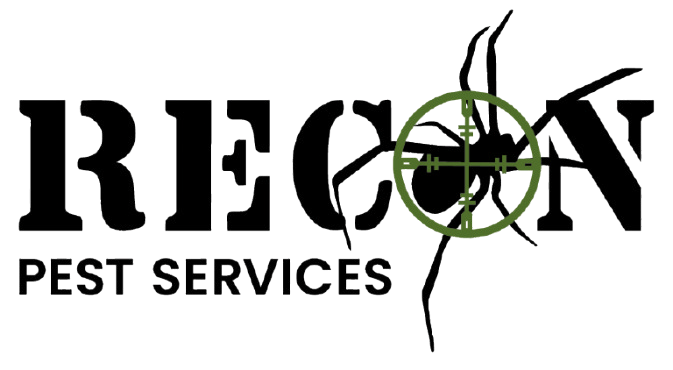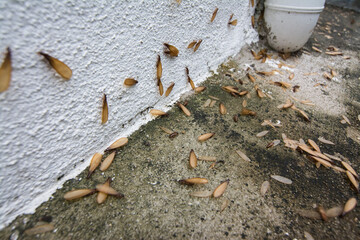Typically found inside homes or within outside nests, termites are a troublesome addition to anyone’s home! These pests can cause thousands of dollars in damage to homeowners across the country as they burrow through wooden structures.
Termite swarmers are typically a homeowner’s first indication of problems in their home if they haven’t spotted other signs. But, what exactly are these winged creeps, and how do you get rid of them once they show their ugly heads?
If you have a termite problem, RECON Pest Services is here to help. Servicing the greater Omaha & Lincon areas, we have the skills and tools needed to take care of even the worst termite problem. Contact us today for a free quote!
Why are Termites Flying Around?
During the spring and summer, many homeowners spot these horrible wood-eating pests flying near their homes and yard. Winged termites can give you early warning of a pest problem if you don’t have other symptoms.
With the arrival of warmer weather, many types of insects become active. You may see more bugs around your home during spring and summer as termites take flight to mate.
The queen termite gives birth to winged reproductive termites known as alates or swarmers once a colony has developed and flourished. Think of swarmers as settlers, looking to find a new home. Unfortunately, your home is a good option for them.
Only a portion of the colony has these reproductive capabilities. Like other insect colony-based species, termite workers are typically infertile, while their flying counterparts can reproduce and create new nests.
Infestation Signs
Besides the visual presence of winged termites, some other signs may indicate an insect issue.
Depending on the species, termites have several identifying characteristics that indicate a problem. Subterranean termites build large colonies underground and connect to your home through small tubes; they live in your yard.
These mud tubes are constructed of dirt and feces, or frass. The subterranean termites travel back and forth through these mud tubes to collect food and bring it back to the nest.
Homeowners typically find these slim tubes near the bottom of their home’s exterior or inside the walls. Easy to miss due to their small size, and winding presence on your wall.
According to the University of Kentucky, disturbing the tubes can help you locate the site of an active infestation. Look for the pale white workers in one of the mud tunnels. If you spot pests, they’re probably gathering food in your house nearby.
Although they dwell inside the walls of your home and feast on wood, drywood termites do not trigger as much destruction as other species that live underground.
If you have a drywood termite infestation, you’ll probably see droppings around their nesting sites. These bugs keep their area clean by making tiny holes in your wall to push out the garbage.
If you see small piles of debris that resemble coffee grounds or wood shavings, this may be an indication of termites in your home. If you spot frass, it’s best to call a professional pest control adrenaline to check for any infestations.
How to Get Rid of Termite Swarmers
So, is there an easy way to get rid of termites from your home? Unfortunately, without help from a certified pest control expert, it’s often difficult to truly get rid of termites. Fortunately, if you only see swarmers, you might have caught the problem early. Here are a few steps you can take to prevent further infestation.
If you have only noticed a few of them, use traps to catch and kill swarmers. Check your local hardware store for termite traps, or make one yourself with a large jar, some wood, and some soapy water.
To make your trap, cut a piece of cardboard to fit the opening of the jar. Next, nail the piece of wood to the cardboard and place the trap outside near an active swarming site. The swarmers will fly to the wood, but won’t be able to escape the soapy water in the jar.
Another way to kill swarmers is to swat them with a fly swatter. This is the least effective method, as you will likely miss more than you hit. Of course, unless you’re a rock star with the swatter, you probably won’t be able to get many of them.
If you have a larger infestation, or if you want to prevent further damage to your home, call a certified pest control expert. They will be able to identify the type of termite in your home and recommend the best course of action for treatment.
Because these pests live in difficult-to-reach spaces, DIY options aren’t the suggested solutions for termites. Whenever you find signs of these pests indoors, the best option is to call RECON Pest Services for help!
Contact us today to schedule a treatment!





